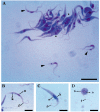A Novel Genotype and First Record of Trypanosoma lainsoni in Argentina
- PMID: 32899895
- PMCID: PMC7558950
- DOI: 10.3390/pathogens9090731
A Novel Genotype and First Record of Trypanosoma lainsoni in Argentina
Abstract
Trypanosomes are a group of parasitic flagellates with medical and veterinary importance. Despite many species having been described in this genus, little is known about many of them. Here, we report a genetic and morphological characterization of trypanosomatids isolated from wild mammals from the Argentine Chaco region. Parasites were morphologically and ultrastructurally characterized by light microscopy and transmission electron microscopy. Additionally, 18s rRNA and gGAPDH genes were sequenced and analyzed using maximum likelihood and Bayesian inference. Morphological characterization showed clear characteristics associated with the Trypanosoma genus. The genetic characterization demonstrates that the studied isolates have identical sequences and a pairwise identity of 99% with Trypanosoma lainsoni, which belongs to the clade of lizards and snakes/rodents and marsupials. To date, this species had only been found in the Amazon region. Our finding represents the second report of T. lainsoni and the first record for the Chaco region. Furthermore, we ultrastructurally described for the first time the species. Finally, the host range of T. lainsoni was expanded (Leopardus geoffroyi, Carenivora, Felidae; and Calomys sp., Rodentia, Cricetidae), showing a wide host range for this species.
Keywords: 18S rDNA genes; Calomys spp.; Leopardus geoffroyi; Trypanosoma lainsoni; gGAPDH genes; morphology; transmission electron microscopy.
Conflict of interest statement
The authors declare no conflict of interest. The funders had no role in the design of the study; in the collection, analyses, or interpretation of the data; in the writing of the manuscript, or in the decision to publish the results.
Figures





References
-
- Vickman K. The Diversity of the kinetoplastid flagellates. In: Lumsden W.H.R., Evans D.A., editors. Biology of the Kinetoplastida. Academic Press; London, UK: New York, NY, USA: San Francisco, CA, USA: 1976. pp. 1–34.
Grants and funding
LinkOut - more resources
Full Text Sources
Miscellaneous

